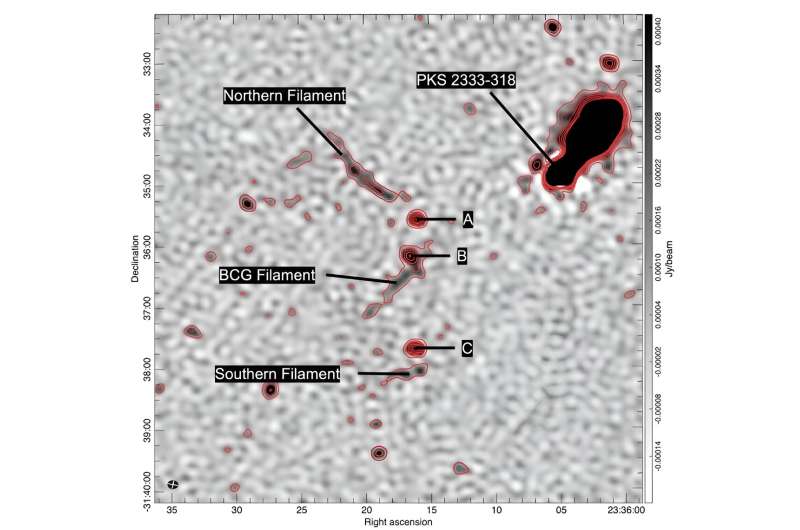June 24, 2024 report
This article has been reviewed according to Science X's editorial process and policies. Editors have highlighted the following attributes while ensuring the content's credibility:
fact-checked
preprint
trusted source
proofread
Observations investigate galaxy cluster Abell S1136

An international team of astronomers has employed the Australian Square Kilometer Array Pathfinder (ASKAP) radio telescope to perform radio observations of a galaxy cluster known as Abell S1136. Results of the observation campaign, published May 23 in Publications of the Astronomical Society of Australia, indicate that the galaxy cluster hosts three narrow filamentary structures.
Galaxy clusters contain up to thousands of galaxies bound together by gravity. They are the largest known gravitationally-bound structures in the universe, and could serve as excellent laboratories for studying galaxy evolution and cosmology.
Abell S1136 is a galaxy cluster located in the Pisces-Cetus supercluster, at a redshift of 0.06. It has a radius of about 2.44 million light years, a mass of approximately 129 trillion solar masses and a luminosity at a level of 5 million QW.
Previous observations of Abell S1136 have found that it showcases a steep-spectrum, diffuse radio emission, which appears like an amorphous radio blob. The observed emission was attributed to a number of cluster radio sources including radio halos, radio relics, and remnant radio galaxies.
However, now, new ASKAP observations of Abell S1136 conducted by a group of astronomers led by Peter. J. Macgregor of the Western Sydney University in Australia, indicate that the diffuse radio emission in the cluster has a more complex structure than previously thought.
"We find that the diffuse radio emission in the center of the cluster shows more structure than seen in previous low-resolution observations of this source, which appeared formerly as an amorphous radio blob, similar in appearance to a radio halo," the researchers wrote in the paper.
ASKAP images of Abell S1136 show a region of diffuse emission about 1,470 light years in extent, three narrow filaments located within the diffuse emission, each about 260–460 light years in extent, and a small number of compact radio sources.
The astronomers underline that the diffuse emission showcases some structure which was not seen in earlier low-resolution observations, and its properties do not closely match either those of a halo or mini-halo.
The researchers note that the three filaments are similar to those found in other cluster sources using high-sensitivity observations. However, they do not rule out the possibility that they represent an unusual wide-angle-tail (WAT) radio source—a powerful, bent radio source typically associated with the dominant galaxy in a cluster or group. Further studies are required in order to determine which hypothesis is true.
The study also found that Abell S1136 shows a distinctive X-ray emission pattern closely aligned with the radio emission from the brightest cluster galaxy. The X-ray temperature profile indicates that the cluster appears to be in a relaxed state, with no evidence of a cool core.
Summing up the results, the authors of the paper conclude that many cluster radio sources, which are regarded as smooth extended sources, may well show more complex structure, as in the case of Abell S1136.
More information: Peter. J. Macgregor et al, Evolutionary Map of the Universe (EMU): Observations of Filamentary Structures in the Abell S1136 Galaxy Cluster, Publications of the Astronomical Society of Australia (2024). DOI: 10.1017/pasa.2024.36. On arXiv: DOI: 10.48550/arxiv.2406.09709
Journal information: arXiv
© 2024 Science X Network




















